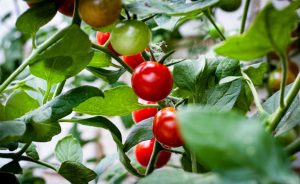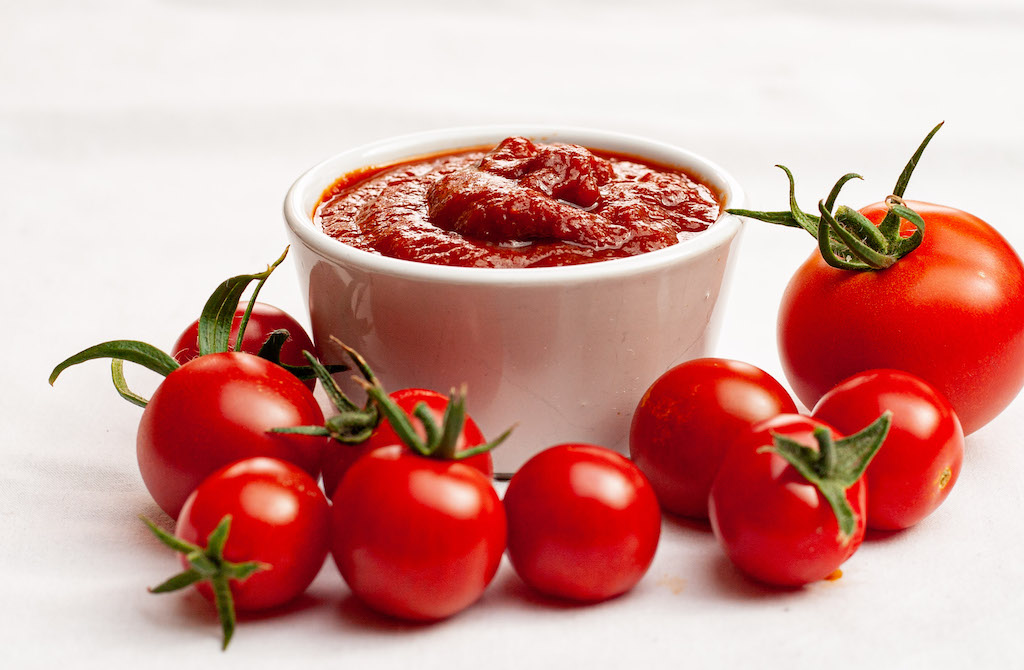At the end of summer, as the evenings draw in, greenhouse tomato vines are burgeoning under the weight of their fruits, ranging from small and emerald green to fully ripened and vivid red. Nurturing tomatoes is done in March when the garden room in our house, with its huge expanses of glass, will resemble a small nursery, as my wife lays out seed trays all over the stone floor, to grow everything for the new season from scratch – from flowers to vegetables; and, of course, tomatoes. It is partly for this reason, and on account of the huge amount of effort that has gone into raising these plants, that it saddens me to watch the tomatoes rot in the vine. Luckily there are plenty of things that you can do with these versatile fruits to ensure that neither they, nor the fruits of your labours, are wasted. This recipe is one of them.

Some preliminary research into the origins of ketchup, takes us to the South-East Asia somewhere between the 17th and 18th Centuries. Back then, a sauce primarily derived from fermented fish called kêt-siap would have been far cry from today’s most popular of table condiments in its characteristically labelled polygonal glass bottle.
The first recipe for ‘ketchup in paste’ can be traced to a gentleman named Richard Bradley, Professor of Botany at the University of Cambridge. Bradley wrote a wonderfully titled publication ‘The Country Housewife and Lady’s Director: in the Management of a House, and the Delights and Profits of a Farm.’ And it includes the following entry ‘Practical observations concerning distilling; with the best method of making ketchup, and many other curious and durable sauces.’ Almost certainly such early recipes contained mushrooms and anchovies in an attempt to replicate the original Asian condiment, and it is not until the beginning of the next century that the tomato appeared on the scene. In 1812 the American horticulturalist, scientist and physician James Mease created his own version of the condiment using tomatoes. Whilst undoubtedly moving away from the dish’s origins of fermented fish and mushrooms, his creation was in actual fact probably more closely aligned with a tomato sauce of the time – which had gained popularity on both sides of the Atlantic through its inclusion in Maria Eliza Rundell’s book A New System of Domestic Cookery. Unfortunately, the absence of vinegar resulted in a relatively short shelf life, meaning that it was almost impossible to keep it for more than a year without a degree of spoiling, or even putrefaction occurring.
Early attempts to solve the problem of preservation led to the use of some fairly nasty substances – now known to be particularly harmful to health – including coal tar and sodium benzoate. And, it wasn’t until 1786 that the now seemingly ubiquitous Henry J Heinz, in partnership with eminent food scientist Dr Harvey Washington Wiley – who had long argued that the need for large amounts of preservatives could be mitigated against by using high quality ingredients – began to produce the world famous bright red table sauce that we now recognise.
For my recipe inspiration I turned to the The River Cottage and Hugh F-W’s recipe, which he in turn has adapted from Lindsey Bareham’s book The Big Red Book of Tomatoes. The River Cottage Cookbook has remained a favourite of mine over the years, and was one of the books that I took with me many years ago when we briefly lived overseas and the amount of possession we could take with us was limited. I am particularly fond of this book, not only because it reminded me of an idyllic rural life back home, but also because it is a book that you can pick up and read, rather than simply being ‘just a cookbook’. Finally, a quick word of warning before you dash out to the greenhouse armed with your trug to harvest tomatoes, or down to the greengrocer or supermarket. If you want a high yield, minimum effort recipe that tastes like the shop-bought stuff, then this is probably not for you. If on the other hand, you want to feel that you have made something, using fresh ingredients, that in my opinion actually tastes better that on the supermarket shelves, and comes with as big a dollop of ‘self satisfaction’ as the dollop you are going to pour out to accompany your favourite dish, then this is definitely for you.
Tomato ketchup
Ingredients
- 3kg ripe tomatoes, roughly chopped
- 4 onions, sliced
- 1 large red pepper, deseeded and chopped
- 100g soft brown sugar
- 200ml cider vinegar
- Quarter tsp mustard powder
- 1 small cinnamon stick
- 1 and a half tsp of allspice
- 1 and a half tsp whole cloves
- 1 and a half tsp ground mace
- 1 and a half tsp celery seeds
- 1 and a half tsp black peppercorns
- 1 bay leaf
- 1 garlic clove, peeled and bruised
- Paprika
- Salt
Instructions
Place the tomatoes, onions and red pepper in a large heavy-bottomed pan – a preserving pan is ideal – and simmer over a medium heat until soft enough to go through a coarse sieve.
Return the sieved liquid to the pan and add the vinegar, and all of the spices, including the garlic clove, tied up in a square of muslin. Bring to the boil and then simmer for about 20-40 minutes until thick and pulpy. The time will depend on how juicy your tomatoes were to begin with.
Once you are happy with the flavour, remove the spice bag, and season to taste with salt and paprika. You can choose to bottle in sterilised jars as you might for chutney, in which case each bottle will keep, unopened, for about 12 months. Or, you can store it in the fridge and use over the course of the next couple of weeks. I suspect most people – unless making larger quantities – will choose the latter.



 (10 votes, average: 4.40 out of 5)
(10 votes, average: 4.40 out of 5)


2 Comments
Yvonne
21/09/2025 at 7:18 pmHi, can you please tell me how much sauce this recipe makes please?
Nigel Eastmond
23/09/2025 at 8:25 pmHi Yvonne. This makes about 2 jam jars worth.